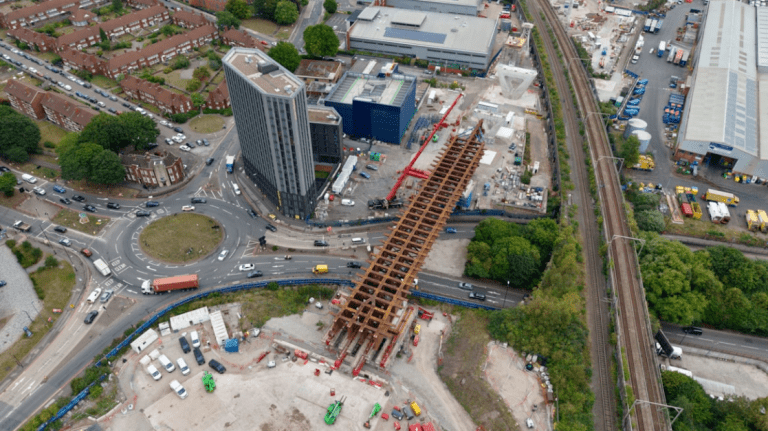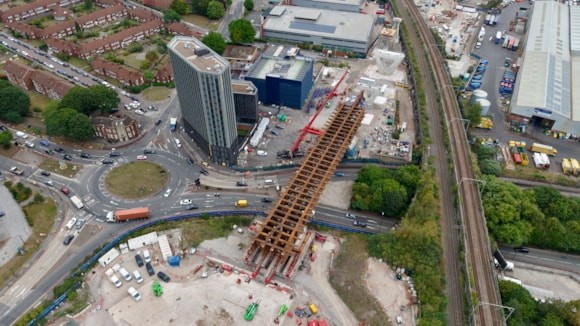Work is set to begin on a £59 million transport project that will link Paisley town centre with the Advanced Manufacturing Innovation District Scotland (AMIDS) and Glasgow Airport. Renfrewshire Council’s AMIDS South project has secured £38.7 million from the UK Government’s Levelling Up Fund, alongside £18.8 million committed by the Council. The investment will deliver a new road bridge across Paisley Harbour, a 1.7km gateway route along the White Cart river, and a network of roads, cycleways and walking links stretching from the town centre’s transport hubs to AMIDS, Glasgow Airport and Inchinnan. The scheme also includes a new road connecting Renfrew Road to the bridge crossing, which will serve the new Paisley Grammar School Community Campus. Dedicated walking and cycling routes are also planned, along with a safe access link from Gallowhill via the underpass on the former railway line, supported by £1.5 million from Transport Scotland. Economic forecasts suggest the project could stimulate an additional £136 million in private sector investment, cut carbon emissions by 21,700 tonnes, and create new job opportunities while enabling existing and future businesses to expand. Renfrewshire Council Leader Iain Nicolson said: “AMIDS is one of the most significant developments in Renfrewshire’s recent history as it will bring high-quality jobs, world-leading industry and provide a significant boost to the area’s economy so it is important that we provide the appropriate access to Scotland’s home of manufacturing innovation. “This project will not only provide infrastructure to better connect communities to education and employment opportunities, but it will also significantly improve the offer to organisations looking to locate here with enhanced access to the airport and the fourth-busiest train station in Scotland. “This will be another flagship project for Renfrewshire following the completion of the Clyde Waterfront and Renfrew Riverside project, which included the new Renfrew Bridge, and will be further proof of the Council’s ability to successfully deliver nationally significant infrastructure projects which bring substantial benefits now and for generations to come.” The new scheme will complement the recently completed Renfrew Bridge, linking Renfrew with Clydebank, Yoker and the wider Glasgow City Region. Local Transport Minister Simon Lightwood added: “Backed by over £38 million in Government funding, this flagship project will deliver a major boost for Paisley and for Scotland as a whole. “The new bridge will provide safer, better-connected transport links for local people, businesses and schools, while driving economic growth and creating thousands of new jobs – a key part of our Plan for Change.” Farrans Construction has been appointed to deliver the project, with completion expected in 2028. Patrick Murray, Scotland’s Regional Director for Farrans, said: “AMIDS South is a project which will deliver major economic and connectivity benefits for the town of Paisley and wider Renfrewshire, and we are looking forward to getting work started on site. “Our experienced team has recently completed the highly successful Govan to Partick Bridge in Glasgow and we have a long history of projects in the transportation sector in Scotland including Edinburgh Trams to Newhaven in joint venture as SFN, M80 Stepps to Haggs and the A737 Dalry Bypass in Ayrshire. We are working through the final stages of preparation with our client Renfrewshire Council and will be engaging on the ground with local stakeholders shortly.” AMIDS South forms the next phase of Renfrewshire Council’s capital investment programme, which has already delivered the award-winning refurbishment of Paisley Town Hall, the renovation of Paisley Arts Centre, creation of the Learning and Cultural Hub, and the near-complete transformation of Paisley Museum. The Council has also committed major long-term investments in Renfrewshire’s roads, pathways and schools, including a ten-year, £90 million programme for roads and up to £170 million for new education facilities. For more information on the AMIDS South project, visit www.renfrewshire.gov.uk/AMIDS-South. Building, Design & Construction Magazine | The Choice of Industry Professionals














